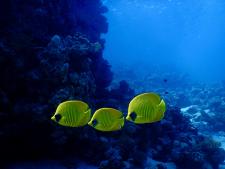Big fish are shrinking and small fish are multiplying, a new study shows

The body sizes of organisms around the world are becoming smaller over time, especially among fish, with important implications for food webs and humans.
Previous research showed that the size of trophy fish in fishing competitions is going down, and that many of the most threatened species are large. This study connects the dots and shows change in body size is the result of not only individuals within species becoming smaller, but also larger species being replaced by smaller ones. "Whether it's because of what humans prefer to eat or their habitats getting warmer, big fish just can't seem to catch a break," explains the lead author Dr Inês Martins from the University of St. Andrews.
The researchers used two sources of body size trait data - direct measurements of biomass taken in the field and average body size estimates from major trait databases - to assess the body size change across over 5,000 ecological assemblage time series spanning 1960-2020. This allowed them to designate body size changes as either a within-species change or a compositional change.
Shrinking was most common among fish, but among other groups of organisms - such as plants and invertebrates - changes were more varied. By looking across groups of species, this study reveals there are some complex changes taking place, with some organisms becoming bigger while others shrink. The authors believe this suggests that when large organisms disappear, other ones try to take up their place and use up the resources that become available.
Reflecting on the importance of these results, co-author Professor Jonathon Chase from iDiv and Martin Luther University Halle-Wittenberg (MLU), adds: "As with most things, changes through time are not always 'one-size-fits-all’. It is important to dig into the complexity of when organisms become smaller or bigger to more thoroughly understand how body size is changing through time."
The study also noted the replacement of a few large organisms with many small ones, while keeping the total amount of life - known as biomass - constant. This surprising result supports the idea that ecosystems tend to compensate for change by keeping overall biomass of the studied species in a particular habitat stable. This stability is attributed to a trade-off between reductions in body size and concurrent increases in abundance among the organisms.
These findings have far-reaching implications for our understanding of how various organisms are adapting to the challenges posed by humans in the Anthropocene era.
The senior author of the paper, Professor Maria Dornelas from the University of St. Andrews, comments: "It is clear the widespread species replacement we see around the world is having measurable consequences. Organisms becoming smaller has important effects as the size of animals mediates their contribution to how ecosystems function, and how humans benefit from them. Bigger fish can usually feed more people than smaller fish."
Currently, there is not enough data to draw clear conclusions for most organisms other than fish. Collecting similar measurements - especially when exploring food webs and other species interactions - stands to significantly benefit future research.
Studie: Martin I. S. et al. Widespread shifts in body size within populations and assemblages. Science (2023). doi: 10.1126/science.adg6006

